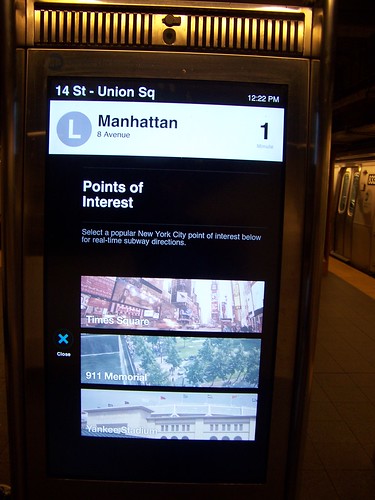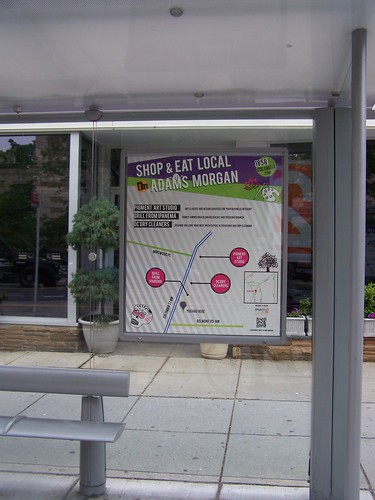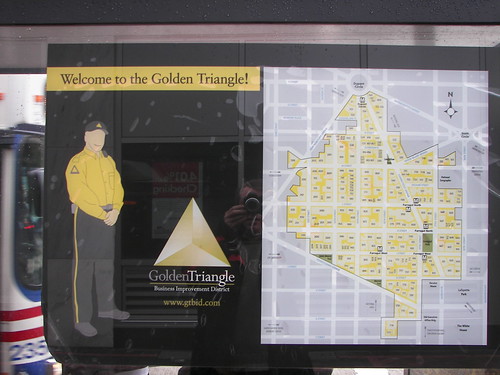Business district and community branding: tougher than it needs to be and DC's Golden Triangle district as an example

The Golden Triangle Business Improvement District covers the area between Farragut Square and Dupont Circle. The BID has invested in public space improvements including a landscaped median on Connecticut Avenue, arty bicycle racks, banners, and programs a number of events in Farragut Square.
Farragut Square is a great asset to build upon, and the Connecticut and K Street intersection might just be the busiest pedestrian intersection in the city.
One of their innovative ideas has been to place movable tables and chairs in Farragut Square, making it easier to eat lunch, as Farragut Square is one of the key staging areas for the city's armada of food trucks.
The problem with the district's identity is that other than the Metro Stations and Farragut Square, there aren't many distinguishing characteristics.
The commercial district is mostly modern office buildings with some hotels, including the Mayflower, the National Geographic Museum, the Sumner School Museum and Archives, and the YMCA. The three Metro stations serve about 70,000 riders daily during the work week. The amount of housing is miniscule.
There are branches of some clothiers such as Burberry, Brooks Brothers, Johnston & Murphy Shoes, while H&M replaced the now out of business Filenes Basement, Nordstrom Rack and the upscale locally owned Rizik wedding boutique, but there isn't critical mass.
There are a bunch of restaurants although chain branches have been closing, and a strip of legacy small commercial buildings on M Street NW and Connecticut Avenue.
 I've thought that if the adjoining property owners were willing, it would be possible to change the building uses around the square to a serious concentration of retail, comparable to Union Square in San Francisco, which is anchored by major department stores, but DC doesn't quite have the population to pull it off.
I've thought that if the adjoining property owners were willing, it would be possible to change the building uses around the square to a serious concentration of retail, comparable to Union Square in San Francisco, which is anchored by major department stores, but DC doesn't quite have the population to pull it off.The BID has had difficulties in recruiting retailers ("Golden Triangle is having to work harder for retail tenants," Washington Post).
Plus this area faces ferocious intra-city competition for high profile retailers from Downtown, Georgetown, and the new CityCenter development.
New banner campaign: fail? The BID has just launched a new banner campaign and I don't think it's very effective in pushing forward branding and identity objectives.
Failed branding isn't unique to the Golden Triangle.
I have written about this issue from time to time using Baltimore ("More (pathetic?) city branding efforts... (Baltimore)") and Georgetown ("Georgetown: A subtle but important difference between branding and identity-positioning") among other examples. (Although the Georgetown post was written about the previous, not current, leadership.)
The banners list the name of the Golden Triangle with the web address, and the street name on which the banner is hung.

Inset from the city's business district profile publication for the Golden Triangle district, DC. One problem with office workers is that they don't do much retail shopping, other than for convenience goods.
The need to take the district's branding to the next level. People already know the street names. What needs to happen is a leveraging of the prominent streets from an individual to a collective identity, to define the area as a distinct and differentiated "district."
In short, the focus needs to be on defining what the Golden Triangle business district is and why it matters.
It happens that earlier in the week, while riding the Metro I saw a well-designed shopping bag featuring the names of New York City streets and key landmarks/attractions (like the Empire State Building), but I wasn't able to get a photo of it.
This business district needs to do a full-fledged branding and identity exercise producing various elements that collectively reinforce a clear definition for the district, which doesn't currently exist. See "(DC) Neighborhoods and commercial districts as brands."
 Ironically I think this is a function of the district's "success" at getting control of the perceptions of an "inner city" district as being dirty and unsafe.
Ironically I think this is a function of the district's "success" at getting control of the perceptions of an "inner city" district as being dirty and unsafe. Now that the Golden Triangle BID has successfully moved the district forward, it needs to take identity and branding to the next level.
Some of the collateral items could include:
- street sign toppers
- banners but with different imagery (e.g. map + street names + images of landmarks)
- maps in bus shelters which exist already, but better supporting a common visual identity and brand
- shopping bags
But these are merely "delivery vehicles" as part of an integrated and comprehensive branding, promotion, and identity system."
I've been meaning to work up a post on neighborhood-commercial district focused digital kiosks at Metro stations, modeled after the kiosks in use in the NYC Subway system, but with a major focus on the local offer and intra-district events. That could be an element as well. The problem with the NYC kiosks is that they don't do much other than show subway maps and ads. There is great potential for the delivery of sub-city information.

A street sign topper with the designation of the Queen West Art & Design District in Toronto. (Photo by Erkin Ozberk.)

A shopping bag with street names. (The NYC imprinted bag I saw was much more visually exciting.)

A shopping bag showing a city skyline.

Adams-Morgan has "funner" maps in bus shelters than Golden Triangle.

Golden Triangle bus shelter map.

Labels: branding-identity, business improvement districts, commercial district revitalization planning






10 Comments:
Well, I'd say they are being very effective at rebranding it from the Herpes Triangle.
In general, I think they have done a good job.
The real issue is declining office jobs. In particular law firms. And the replacement -- nonprofit workers -- don't have anywhere near the same incomes.
It's my favorite part of downtown, mostly because i have been working in it for almost 20 years!
And partying there too -- hence the other name.
I'd apply the corridor concept. 19th is becoming such a corridor. L can can becomeone, double so with the bike lane.
Real problem is it is dead on weekends. closing the Farragut metro stop isn't helping.
I'd also do a better job working with the IMF/WB.
I guess that's what makes it hard. The "corridors" that are "popular" are mostly sections of old buildings, although not completely.
But you're absolutely right that they need to consider focusing on enlivening sub districts and activation at the street level.
I added a photo near the top of 19th St. It's pretty grim looking. OTOH, Daily Grill is close and has a lot of potential.
Reston Town Center is a good example that ground floor spaces in modern office buildings can be designed and developed to be open, welcoming, and active.
Sorry, to be clear I think 19th is a growing success on the "eatery" side. Part of it is concentration for the lunch crowd, part of it is a easy corridor for GW students.
Paying for Saturday parking is clearly hurting the GT as well. You need time limts but no need for meters. The bike lane on L has not helped there.
Part of the issue is I think the landords are keeping vacancy rates at certain targets to demostrate a need for reduced property taxes. Also, conversely, the values are NOT high enough yet to encouage a tear down.
The information kioks could be combined with bikeshare and food truck information. I don't think car2go i allowed there because of rush hour rules.
You guys need to visit after hours.
19th Street is a club/bar scene for suburbanites from Thurs thru early Sunday morning and doesn't evening get rollicking until midnite. Lotta drinking and rowdiness on the streets at closing time also. Connecticut Avenue is like an outdoor BoomBoom Room from late spring to early fall. GT BID has had one helluva time keeping the kiddies reined in after they leave the bar--10-12,000 drunk patrons out on the streets simultaneously. Really vibrant...
-EE
... I used to work in one of those places....
But this post is about the branding...
There was even an underground dance place that the waitresses liked--The Cellar--at M Street and 20th(?). I always wonder about what happened to that space.
E.g. how Buffalo Billiards took well located but seemingly marginal space, underground at a Dupont Circle building but with some light wells, and made it very successful.
The Cellar had no light wells.
The point I was attempting to make is that if you don't know your product, "branding" may turn out to be just so much lipstick on a pig.
-EE
And it's tough when your "product" is so many different things, including a day time office district and a night time string of bars... That's hard to reconcile.
As Charlie posits, GT BID has actually done an admirable job on the daytime commercial aspect of it and the MPD has started to crack down on the nighttime craziness, especially up in the Dupont area (many more residents being negatively affected), in the last couple of years.
This raises the larger quality of life issues for residents vs. commercial development in these downtown areas. It would behoove the city to do a cost-benefit analysis of these downtown neighborhoods in terms of commercial, non-profit, NGO vs. residential.
-EE
This is a great post.
This post is about DC's Golden Triangle district.
The Golden Triangle is the core of DC's business locale, extending from the front yard of the White House to Dupont Circle.
Post a Comment
<< Home